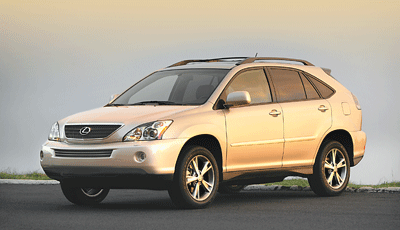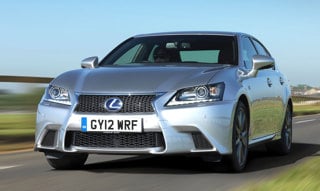Review
A few seconds later, the radio starts playing, the air-con puffs a lukewarm breeze in my face and the headlights come on. But still no engine action. “What are you waiting for?” asks my passenger. “Stab the throttle. Let’s go.”
Gerald Killmann knows what he’s talking about, since he’s the general manager responsible for powertrain engineering at the Toyota technical centre in Brussels. I do as I’m told and our RX400h takes off gracefully, humming as it approaches the first junction, where a pedestrian discovers it’s no longer safe to rely on ears alone before crossing the road.
Having dodged him, I nail the accelerator, summoning the petrol-fed V6 to assist the electric motor, giving a combined maximum output of 268bhp – according to Lexus the performance of a V8 with the frugality of a big displacement four-cylinder.
We’re driving in drizzle and through Belgian villages in what would be an otherwise familiar looking car if it weren’t for the ‘h’ badge symbol on the tailgate. This signifies Hybrid Synergy Drive, the technology that makes this RX appeal to wealthy eco-weenies, although when it comes to the UK this summer, priced from about £40,000, it is unlikely to get London Congestion Charge exemption.
In the wake of the clean-air RX, Toyota’s upmarket division will soon launch the GS450h (unveiled at the New York Auto Show last month), the LS600h and possibly a multi-motor derivative of the next IS. Even the LF-A supercar concept, displayed in Detroit, may end up with an auxiliary powerplant using similar technology.
The Prius and RX400h, as well as the new Hondas, show that hybrid technology is here to stay. It’s an environmentally-friendly and user-friendly solution which can help patch the holes in the ozone layer. Even the stubborn Germans have sussed this – Mercedes will have a hybrid S-class in 2007, BMW will offer an intelligent energy version of the X5, and VW is considering a diesel hybrid for the Touareg from which the Porsche Cayenne could also benefit.
Toyota won’t stand still and let the others catch up, though. It’s already conceived new software to further optimise the charge and recharge cycle as well as higher-revving and higher voltage electric motors, and in 2009 it will switch from nickel hydride to smaller, lighter and more energy efficient lithium ion batteries.
As it stands, this is a highly sophisticated but extremely complicated piece of kit.

Behind the wheel
Our RX400h test car is an early US-spec mule with spongey brakes, mushy suspension and indifferent steering, but the unique drive train is in place.
Fitted with a smooth-acting CVT transmissions, the two-tonner accelerates seamlessly. It gives an experience that is well out of the ordinary. At low speeds, when just the front electric motor is in use, driving the front wheels, the RX buzzes like a swarm of bees. Normal cruising adds the petrol engine. again driving the front wheels.
Under hard acceleration, the rear motor joins in, driving the rear wheels. Your right foot needs to learn the point at which the petrol engine kicks in and to get used to the idea that the brake pedal triggers not only deceleration, but also regeneration. You need to trust the control units.

Strengths: Helps save the planet: economical, fairly clean
Weaknesses:Weird driving experience, distracting Disney-style dash display
Opportunity: To save car owners from eco-legislation
Threats: If it’s all so effective, why isn’t the whole world jumping on the bandwagon?
USP: Part-time zero emissions, part-time V8-equivalent power
Price: £40,000 (est)
Engine: 3.3-litre petrol V6, front and rear electric motors, combined peak output 268bhp
Transmission: Continuously variable; intelligent electric part-time four-wheel drive
Performance: 0-62mph 7.6sec, top speed 125mph (gov)
Efficiency: 34.7mpg (comb), 192g/km CO2
Rivals:Mercedes S-class (2007), BMW X5 (TBC), VW Touareg (TBC)

Factsheet
No information available.














